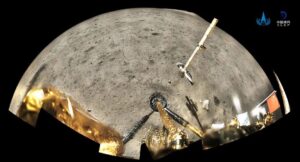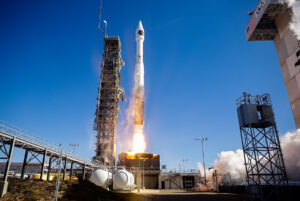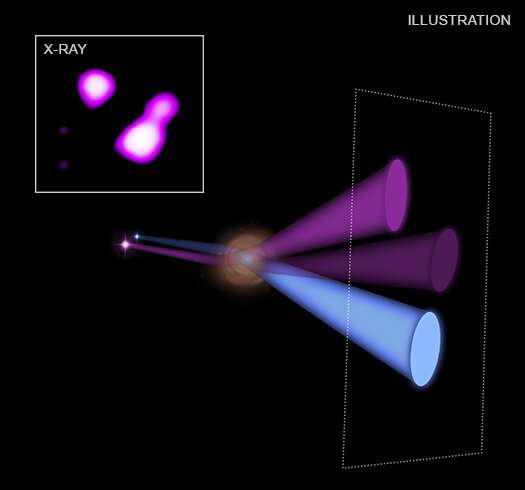Inspiration4 crew will conduct health research during three day mission
Wednesday, 01 September 2021 03:30 The crew of Inspiration4 will partake in a first-of-its-kind health research initiative to increase humanity's knowledge on the impact of spaceflight on the human body. Once in orbit, the crew will perform carefully selected research experiments on human health and performance, which will have potential applications for human health on Earth and during future spaceflights.
Additionally, Sp
The crew of Inspiration4 will partake in a first-of-its-kind health research initiative to increase humanity's knowledge on the impact of spaceflight on the human body. Once in orbit, the crew will perform carefully selected research experiments on human health and performance, which will have potential applications for human health on Earth and during future spaceflights.
Additionally, Sp Air Force rescue crews ready in case of SpaceX, Boeing launch malfunctions
Wednesday, 01 September 2021 03:30 U.S. Air Force rescue teams have completed training in preparation for possible emergency bailouts of space launches by SpaceX and Boeing.
The training took place last week in the Atlantic Ocean and the Banana River near the Florida-based Patrick Space Force Base, the Air Force said Monday in a press release.
The teams included pararescuemen, airmen and maritime operations from t
U.S. Air Force rescue teams have completed training in preparation for possible emergency bailouts of space launches by SpaceX and Boeing.
The training took place last week in the Atlantic Ocean and the Banana River near the Florida-based Patrick Space Force Base, the Air Force said Monday in a press release.
The teams included pararescuemen, airmen and maritime operations from t Application of fission-powered spacecraft in solar system exploration missions
Wednesday, 01 September 2021 03:30 The universe, and everything it encompasses, has kindled the curious human mind for ages, leading to numerous "eureka" moments in understanding the intricacies of "outer space." Several manned and unmanned space explorations have been successfully deployed to date, using chemical energy and solar energy as the primary sources of energy. However, these sources may not be very energy-efficient or
The universe, and everything it encompasses, has kindled the curious human mind for ages, leading to numerous "eureka" moments in understanding the intricacies of "outer space." Several manned and unmanned space explorations have been successfully deployed to date, using chemical energy and solar energy as the primary sources of energy. However, these sources may not be very energy-efficient or NASA prompts companies for Artemis Lunar Terrain Vehicle Solutions
Wednesday, 01 September 2021 03:30 NASA is asking American companies for additional input on approaches and solutions for a vehicle to transport Artemis astronauts around the lunar South Pole later this decade. The lunar terrain vehicle (LTV), an unenclosed rover that astronauts can drive on the Moon while wearing their spacesuits, will need to last at least 10 years, spanning multiple Artemis missions.
Through a request fo
NASA is asking American companies for additional input on approaches and solutions for a vehicle to transport Artemis astronauts around the lunar South Pole later this decade. The lunar terrain vehicle (LTV), an unenclosed rover that astronauts can drive on the Moon while wearing their spacesuits, will need to last at least 10 years, spanning multiple Artemis missions.
Through a request fo X-ray magnifying glass enhances view of distant black holes
Wednesday, 01 September 2021 03:30 A new technique using NASA's Chandra X-ray Observatory has allowed astronomers to obtain an unprecedented look at a black hole system in the early Universe, as reported in our latest press release. This is providing a way for astronomers to look at faint and distant X-ray objects in more detail than had previously been possible.
Astronomers used an alignment in space that shows "gravitatio
A new technique using NASA's Chandra X-ray Observatory has allowed astronomers to obtain an unprecedented look at a black hole system in the early Universe, as reported in our latest press release. This is providing a way for astronomers to look at faint and distant X-ray objects in more detail than had previously been possible.
Astronomers used an alignment in space that shows "gravitatio An accidental discovery hints at a hidden population of cosmic objects
Wednesday, 01 September 2021 03:30 A new study offers a tantalizing explanation for how a peculiar cosmic object called WISEA J153429.75-104303.3 - nicknamed "The Accident" - came to be. The Accident is a brown dwarf. Though they form like stars, these objects don't have enough mass to kickstart nuclear fusion, the process that causes stars to shine. And while brown dwarfs sometimes defy characterization, astronomers have a good
A new study offers a tantalizing explanation for how a peculiar cosmic object called WISEA J153429.75-104303.3 - nicknamed "The Accident" - came to be. The Accident is a brown dwarf. Though they form like stars, these objects don't have enough mass to kickstart nuclear fusion, the process that causes stars to shine. And while brown dwarfs sometimes defy characterization, astronomers have a good Israel Space Agency selects Ramon.Space for computing payload
Wednesday, 01 September 2021 03:30 Ramon.Space has been selected by the Israel Space Agency to provide a space computing payload for a mission scheduled to launch in early 2022. As part of the mission, Ramon.Space digital payload will perform computing on-orbit including software updates and upgrades using the company's programmable space computing systems.
Ramon.Space high performance computing systems are based on in-hous
Ramon.Space has been selected by the Israel Space Agency to provide a space computing payload for a mission scheduled to launch in early 2022. As part of the mission, Ramon.Space digital payload will perform computing on-orbit including software updates and upgrades using the company's programmable space computing systems.
Ramon.Space high performance computing systems are based on in-hous Researchers biomines vanadium aboard ISS
Wednesday, 01 September 2021 03:30 For centuries, humans have mined materials to build the tools we use every day, from batteries and cell phones to airplanes and refrigerators. While the process of obtaining these important minerals used to rely entirely on heavy machinery, fire, and human labor, scientists have learned how to harness the natural power of microbes to do some of the work.
This process, called biomining, has
For centuries, humans have mined materials to build the tools we use every day, from batteries and cell phones to airplanes and refrigerators. While the process of obtaining these important minerals used to rely entirely on heavy machinery, fire, and human labor, scientists have learned how to harness the natural power of microbes to do some of the work.
This process, called biomining, has Spacecraft deorbiting device developed at Purdue ready for upcoming test launch
Wednesday, 01 September 2021 03:30 A drag sail that a team at Purdue University developed to pull launch vehicles in space back to Earth is scheduled to undergo a test launch on Thursday (Sept. 2).
The mission, set to take off from Vandenberg Space Force Base in California, will evaluate how well the prototype helps its vehicle deorbit from space after mission completion. A livestream of the launch will be available through
A drag sail that a team at Purdue University developed to pull launch vehicles in space back to Earth is scheduled to undergo a test launch on Thursday (Sept. 2).
The mission, set to take off from Vandenberg Space Force Base in California, will evaluate how well the prototype helps its vehicle deorbit from space after mission completion. A livestream of the launch will be available through World-leading space venture capital firm announces idea-stage incubator
Wednesday, 01 September 2021 03:30 SpaceFund has announced at the North American Space Summit, the formation of its SpaceFund Labs idea incubator. The goal of this new division of SpaceFund is to capture and turn exciting ideas into funded businesses by creating a unique incubation plan for each idea that is accepted into the program.
"SpaceFund Labs is about discovering and nurturing the most brilliant ideas in AI, biotech
SpaceFund has announced at the North American Space Summit, the formation of its SpaceFund Labs idea incubator. The goal of this new division of SpaceFund is to capture and turn exciting ideas into funded businesses by creating a unique incubation plan for each idea that is accepted into the program.
"SpaceFund Labs is about discovering and nurturing the most brilliant ideas in AI, biotech Roscosmos offered ESA extended use of Soyuz In French Guiana
Wednesday, 01 September 2021 03:30 Russian space agency Roscosmos has offered the European Space Agency (ESA) to continue using Russia's Soyuz carrier rockets from the Kourou spaceport in French Guiana for different payloads, and the talks are ongoing, ESA Director General Josef Aschbacher told Sputnik.
"The extended use of Soyuz is one of the topics we're considering right now. In fact, I have discussed it with Mr. [Dmitry
Russian space agency Roscosmos has offered the European Space Agency (ESA) to continue using Russia's Soyuz carrier rockets from the Kourou spaceport in French Guiana for different payloads, and the talks are ongoing, ESA Director General Josef Aschbacher told Sputnik.
"The extended use of Soyuz is one of the topics we're considering right now. In fact, I have discussed it with Mr. [Dmitry A Lunar-based Soft X-ray Imager for the Earth's magnetosphere
Wednesday, 01 September 2021 03:30 The solar wind-magnetosphere coupling and its dynamic process are the basic driving factors for space weather. To understand its physical connotation, it is necessary to understand the processes of global scale responses, mass and energy transportation, and the coupling between different regions.
However, relying on single-point or multi-point in-situ measurements is not enough for graspin
The solar wind-magnetosphere coupling and its dynamic process are the basic driving factors for space weather. To understand its physical connotation, it is necessary to understand the processes of global scale responses, mass and energy transportation, and the coupling between different regions.
However, relying on single-point or multi-point in-situ measurements is not enough for graspin NASA has no plans to exchange lunar samples with China
Wednesday, 01 September 2021 00:31
NASA currently has no plans to trade any of its Apollo-era lunar samples with those returned by China’s Chang’e-5 mission, although then agency’s chief scientist held out hope for such an exchange in the future.
Liquid nitrogen shortage delays Landsat 9 launch
Tuesday, 31 August 2021 23:28
A one-week delay in the launch of the next Landsat satellite on an Atlas 5 is the result of a ripple effect in the supply chain caused by increased demand for liquid oxygen to treat COVID-19 patients.
'X-ray magnifying glass' enhances view of distant black holes
Tuesday, 31 August 2021 18:19
By taking advantage of a natural lens in space, astronomers have captured an unprecedented look at X-rays from a black hole system in the early universe.
This magnifying glass was used to sharpen X-ray images for the first time using NASA's Chandra X-ray Observatory. It captured details about black holes that would normally be too distant to study using existing X-ray telescopes.
Astronomers applied a phenomenon known as "gravitational lensing" that occurs when the path taken by light from distant objects is bent by a large concentration of mass, such as a galaxy, that lies along the line of sight. This lensing can magnify and amplify the light by large amounts and create duplicate images of the same object. The configuration of these duplicate images can be used to decipher the complexity of the object and sharpen images.
The gravitationally-lensed system in the new study is called MG B2016+112.

